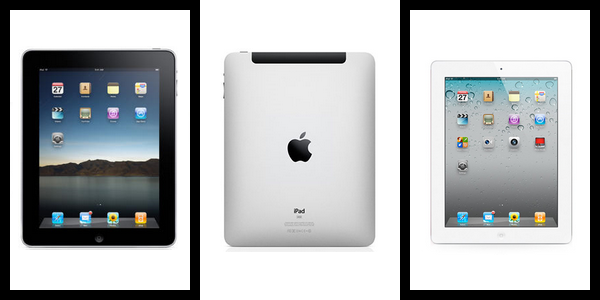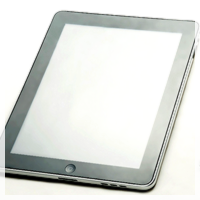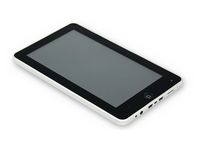
Make your predictions now, techies. How long until laptops are completely phased out by tablet PCs?
It might be way too early to claim all laptops are obsolete, but there is certainly an expanding market for tablet computers in recent times. According to the Olswang Convergence Survey 2011, around 5% of Americans own a tablet computer of some kind. The increased usage and demand for this product is generated by the iPad launch in 2010 (and in typical Apple fashion, they released the enhanced iPad 2 model just one year later). Not to be outperformed by the big almighty Apple company, a total of 14 different brands of tablet PCs were released during 2011, while at least 6 more brands will join the market within the upcoming months.
By the economic laws of supply and demand, there has to be a sizable amount of consumer demand to correspond with the upsurge in supply. This article will explore the pros and cons of tablet PCs in contrast to desktops and laptop computers. There will also be an in-depth price and brand comparison between the many models that have been recently released. Which tablet PC is right for you?
Analysis
Consider the following attributes of tablet PCs, in comparison to other desktop and laptop computers:
1.) Portability - Mobility has become infused with technology. The ability to carry an electronic device anywhere is a key selling point for consumers, because it opens up communication borders and breaks down geographic barriers. Computers are no longer confined within one location; they can be used anywhere and at any time.
For the same reason why cell phones have replaced telephones, the tablet PC is an ideal substitute for computers and even laptops due to its portability. Imagine the scenario where a family is going on vacation, and the children would like to watch a digital movie while waiting at the airport; carrying a tablet PC is much more convenient and accessible than a larger and clunkier laptop.
2.) Functionality - Naturally, it is easy to see why tablet PCs have become a trendy commodity. They are like the smaller, thinner, and lighter models of laptops with nearly the same capabilities. Yet, they also resemble the larger, clearer and more functional versions of cell phones or other mobile devices.
Combining the best of both worlds, the tablet computer is a happy medium that allows users to access the complex functions of a laptop in the simplistic size of a cell phone. Best of all, these tablet computers are also very convenient. They rely on touch-based technology for its primary operations, thus reducing the need to type in a keyboard or click on a mouse.
3.) Limitations - Unfortunately, tablet PCs are limited in the sense that they do not have the full spectrum of capabilities as an ordinary computer. The tablet allows for basic functions such as e-mail and social media applications, but there are not many sophisticated apps or software developed for this platform at the moment.
Most tablets also do not permit the user to run more than one application at a time, which might severely reduce productivity and efficiency. If you are looking to use the advanced processes of a computer, do not expect that the tablet PC will perfectly supplement all your needs. The device is best suited for e-mail communication, instant messaging, social media, browsing websites, and viewing movies.
4.) Price - As with most new technological products, perhaps the biggest drawback to the tablet PC is its expensive price. Even the most basic model of the iPad, at 16GB with limited capabilities, was initially sold at the minimum retail price of $499. This amount did not account for the numerous costly add-ons, such as the 3-G functionality or various enhancement apps.
The price could easily go as high as the four-digit range for the more expensive models. For example, the Fujitsu Lifebook is in the $1000 to $2000 price range for a convertible model (in which the laptop monitor can be flipped over and converted into a tablet screen). Thankfully, the recent increase of suppliers in the market has led to more competitive prices for the commodity.
Consider the following attributes of tablet PCs, in comparison to other desktop and laptop computers:
1.) Portability - Mobility has become infused with technology. The ability to carry an electronic device anywhere is a key selling point for consumers, because it opens up communication borders and breaks down geographic barriers. Computers are no longer confined within one location; they can be used anywhere and at any time.
For the same reason why cell phones have replaced telephones, the tablet PC is an ideal substitute for computers and even laptops due to its portability. Imagine the scenario where a family is going on vacation, and the children would like to watch a digital movie while waiting at the airport; carrying a tablet PC is much more convenient and accessible than a larger and clunkier laptop.
2.) Functionality - Naturally, it is easy to see why tablet PCs have become a trendy commodity. They are like the smaller, thinner, and lighter models of laptops with nearly the same capabilities. Yet, they also resemble the larger, clearer and more functional versions of cell phones or other mobile devices.
Combining the best of both worlds, the tablet computer is a happy medium that allows users to access the complex functions of a laptop in the simplistic size of a cell phone. Best of all, these tablet computers are also very convenient. They rely on touch-based technology for its primary operations, thus reducing the need to type in a keyboard or click on a mouse.
3.) Limitations - Unfortunately, tablet PCs are limited in the sense that they do not have the full spectrum of capabilities as an ordinary computer. The tablet allows for basic functions such as e-mail and social media applications, but there are not many sophisticated apps or software developed for this platform at the moment.
Most tablets also do not permit the user to run more than one application at a time, which might severely reduce productivity and efficiency. If you are looking to use the advanced processes of a computer, do not expect that the tablet PC will perfectly supplement all your needs. The device is best suited for e-mail communication, instant messaging, social media, browsing websites, and viewing movies.
4.) Price - As with most new technological products, perhaps the biggest drawback to the tablet PC is its expensive price. Even the most basic model of the iPad, at 16GB with limited capabilities, was initially sold at the minimum retail price of $499. This amount did not account for the numerous costly add-ons, such as the 3-G functionality or various enhancement apps.
The price could easily go as high as the four-digit range for the more expensive models. For example, the Fujitsu Lifebook is in the $1000 to $2000 price range for a convertible model (in which the laptop monitor can be flipped over and converted into a tablet screen). Thankfully, the recent increase of suppliers in the market has led to more competitive prices for the commodity.
Top 10 Recommendations for Tablet PCs in 2011
A.) Apple iPad 2 (1024x768) - Apple
The new and improved model of the iPad is slightly lighter than its predecessor at 600g weight. Like most Apple products, the design is sleek and highly compatible with the company's products. It comes with approximately 10 hours of battery life and the much requested camera functions.
B.) Archos 101 (1024x600) - Android
This is one of the lightest 8" tablet PCs in the market right now at 480g weight and 12mm thickness It comes with WiFi, a webcam, and hi-definition multimedia capabilities.
C.) ASUS Eee Pad Transformer (1280x800) - Android
The Eee Pad is sized at 680g weight and 13mm thickness. Its battery life lasts as long as 16 hours. It comes with a full QWERTY and touch pad keyboard, allowing the user to attach the tablet to an external device whenever necessary.
D.) BlackBerry PlayBook (1024x600) - Blackberry Tablet OC
The petite BlackBerry brand tablet is sized at only 194mm height and 425g weight along with a 5" screen. It comes with WiFi, Adobe Flash Player, and hi-def cameras on both sides of the tablet.
E.) Dell Streak 7 (800x480) - Android
This 7" Dell tablet is one of the smaller models and weighs only 450g. It comes with a rear and front-facing camera, along with WiFi capabilities. The tablet also boasts flexible pricing plans for its basic and 4G models.
F.) ExoPC Slate (1366x768) - Windows
This tablet PC has one of the largest display resolution in the market. The platform weighs at 950g. It comes with WiFi, webcam, speaker, microphone, and 4 hours of battery life.
G.) HP TouchPad (1024x768) - webOS
The HP TouchPad weighs 740g. It allows the user to multitask and switch between different applications at the same time (although the performance varies based on usage). It comes with wiFi and 16GB-32GB memory storage.
H.) Motorola Xoom (1280x800) - Android
The Motorola brand tablet weighs at 730g with the Adobe Flash 10 player already pre-installed. It has both a front-facing and rear-facing camera. Many Motorola accessories are available to satisfy your convenient needs.
I.) Samsung Galaxy Tab (1280x800) - Android
This is one of the thinner tablet PCs at 8.6mm thickness and 470-600g weight. It has a 'mini apps tray' that allows the user to multitask with two applications open at a time. The tablet also comes with HD video and Flash playback along with a easy social media interface. It will be made available in the market during this summer.
J.) Toshiba Tablet (1280x800) - Android
The Toshiba brand tablet weighs at 771g. It comes with WiFi, Flash, a front-facing webcam and autofocus camera. The tablet will be made available in markets during this summer. Unlike most of the products in the market, the Toshiba tablet is available in a variety of different colours.
The new and improved model of the iPad is slightly lighter than its predecessor at 600g weight. Like most Apple products, the design is sleek and highly compatible with the company's products. It comes with approximately 10 hours of battery life and the much requested camera functions.
B.) Archos 101 (1024x600) - Android
This is one of the lightest 8" tablet PCs in the market right now at 480g weight and 12mm thickness It comes with WiFi, a webcam, and hi-definition multimedia capabilities.
C.) ASUS Eee Pad Transformer (1280x800) - Android
The Eee Pad is sized at 680g weight and 13mm thickness. Its battery life lasts as long as 16 hours. It comes with a full QWERTY and touch pad keyboard, allowing the user to attach the tablet to an external device whenever necessary.
D.) BlackBerry PlayBook (1024x600) - Blackberry Tablet OC
The petite BlackBerry brand tablet is sized at only 194mm height and 425g weight along with a 5" screen. It comes with WiFi, Adobe Flash Player, and hi-def cameras on both sides of the tablet.
E.) Dell Streak 7 (800x480) - Android
This 7" Dell tablet is one of the smaller models and weighs only 450g. It comes with a rear and front-facing camera, along with WiFi capabilities. The tablet also boasts flexible pricing plans for its basic and 4G models.
F.) ExoPC Slate (1366x768) - Windows
This tablet PC has one of the largest display resolution in the market. The platform weighs at 950g. It comes with WiFi, webcam, speaker, microphone, and 4 hours of battery life.
G.) HP TouchPad (1024x768) - webOS
The HP TouchPad weighs 740g. It allows the user to multitask and switch between different applications at the same time (although the performance varies based on usage). It comes with wiFi and 16GB-32GB memory storage.
H.) Motorola Xoom (1280x800) - Android
The Motorola brand tablet weighs at 730g with the Adobe Flash 10 player already pre-installed. It has both a front-facing and rear-facing camera. Many Motorola accessories are available to satisfy your convenient needs.
I.) Samsung Galaxy Tab (1280x800) - Android
This is one of the thinner tablet PCs at 8.6mm thickness and 470-600g weight. It has a 'mini apps tray' that allows the user to multitask with two applications open at a time. The tablet also comes with HD video and Flash playback along with a easy social media interface. It will be made available in the market during this summer.
J.) Toshiba Tablet (1280x800) - Android
The Toshiba brand tablet weighs at 771g. It comes with WiFi, Flash, a front-facing webcam and autofocus camera. The tablet will be made available in markets during this summer. Unlike most of the products in the market, the Toshiba tablet is available in a variety of different colours.









No comments:
Post a Comment